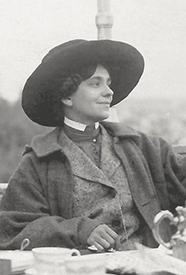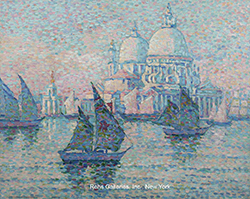BIOGRAPHY - Jeanne Selmersheim-Desgrange (1877 - 1958)

Born on January 27, 1877, Jeanne Desgrange grew up in a family of artists and architects. On her mother’s side, she was descended from the respected eighteenth century painter of everyday life, Jean-Baptiste Greuze (1725-1805). Her maternal grandmother was a well known fashion illustrator, working primarily for La Mode Illustrée; her great uncle was the painter Auguste Leloir and her grandfather was the architect Gabriel Toudouze. Jeanne’s mother, Isabelle Toudouze (1850-1907), and her uncle Edouard were also professional painters. Not surprisingly, young Jeanne began her career in the decorative arts, specializing in jewelry design.
In her twenties, she met and married the architect Pierre Selmersheim (1869-1941). He too came from a family of architects; his father Paul Selmersheim was a diocesan architect for the French Catholic church who spent most of his career working on the restoration of historical monuments. Likewise, Pierre’s brother Tony Selmersheim worked as an architect and interior designer. In short, Jeanne Selmersheim-Desgrange spent the first few decades of her life surrounded by people dedicated to the visual arts. During their relatively brief marriage, she and Selmersheim had three children together.
In 1909, Selmersheim-Desgrange decided to shift her artistic focus to painting, and she begin studying with Paul Signac (1863-1935). He was closely associated with Georges Seurat and Camille Pissarro—and with the development of the neo-Impressionist movement known as Pointillism. Shortly after Selmersheim-Desgrange and Signac started working together, the two became lovers although both were still married. Within a year, both were divorced and living together in St. Tropez on the Mediterranean. [i] Signac had purchased a small house there some years earlier and it was at “La Hune” that he and Selmersheim-Desgrange made their home. The landscape of southern France and the coastal fishing community of St. Tropez proved an inspiration for her. Most of her paintings capture daily life in this relaxed and sunny place.
During her first years in St. Tropez, Selmersheim-Desgrange focused her attention on still life paintings, often domestic objects like coffee pots, plates and wine bottles positioned on a casual dining table. This may reflect the fact that she and Signac had a daughter, Ginelle, born in October 1912; her ability to travel would have been curtailed to some degree when her daughter was very young. With the onset of World War I in 1914, they were undoubtedly even more restricted in their travels. In addition, Signac was deeply troubled by the war, which interrupted his work until 1920. [ii]
The decade of the 1920s brought a fresh sense of energy and with it, a return to long painting trips, often sailing along the coast to Antibes, Marseilles and Nice. They also traveled through France—to Paris and to Normandy, Brittany and Picardie. Although Signac and Selmersheim-Desgrange never married, their daughter was legally adopted by her father in 1927 in order to ensure that she would be able to inherit his estate.
After Signac’s death in 1935, Selmersheim-Desgrange continued to live and work in St. Tropez. Over the coming decades, she would emerge as a respected figure in the community, participating regularly in exhibitions as the small fishing village evolved into a tourist destination after World War II. Selmersheim-Desgrange died at age eighty-one on April 30, 1958.
Janet Whitmore, Ph.D.
Selected Museums
Musée de l'Annonciade, Saint-Tropez, France
Musée de Grenoble, Switzerland
Finnish National Gallery Ateneum, Helsinki
Indianapolis Museum of Art, Indiana
Portland Art Museum, Portland, Oregon
[i] Fred Leeman, Impressionism and Beyond, A Wonderful Journey (Laren, The Netherlands: Thoth Publishers in association with the Singer Laren Museum, 2018) 102. Exhibition catalogue. Leeman notes that meeting Selmersheim-Desgrange energized Signac’s art, acting as a catalyst for his exploration of the water colors that would become his signature medium.
[ii] Ibid.

